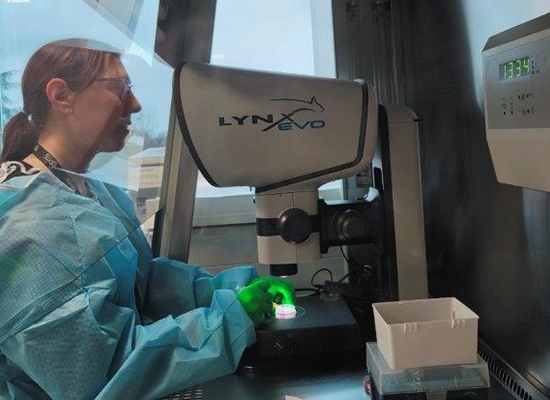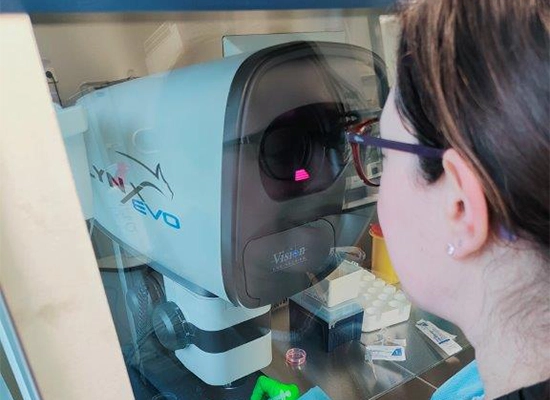In stem cell research cleanliness is paramount for quality, compliance and innovation. Traditional microscopy techniques often lack the capabilities required for intricate cell manipulation tasks. Clarity of vision and ergonomic comfort are important considerations in ensuring reliable data and successful experiments, but more critical is the ability to avoid contamination and maintain sterility, while working within a laminar flow cabinet. Conventional equipment, therefore, has limitations hindering the progress of ground-breaking research initiatives.
Enter the Lynx EVO stereo microscope by Vision Engineering—an innovative solution that is redefining the landscape of stem cell inspection.
What sets it apart is the unique capability to allow researchers to complete these tasks within a clean laminar flow cabinet.

The Institute of Genetics, Molecular and Cellular Biology (IGBMC), a leading European research centre, is based at the University of Strasbourg and works alongside the French National Centre for Scientific Research (CNRS).
Amélie Freismuth, Head of the Cell Culture at the IGBMC, is using the Lynx EVO to study and manipulate human stem cells, known as induced pluripotent stem cells (iPSCs):
“We use this observation solution for the cultivation and mechanical passage by cutting of human induced pluripotent stem cells.
These cells are used to model various human pathologies and test the effectiveness and toxicity of potentially therapeutic molecules.”
Reprogramming adult cells into iPSCs involves introducing specific genes into the cells, which resets their developmental state, transforming them into cells with the potential to become any cell type in the body. iPSCs are valuable in research because they can be used to study diseases, model human development, and potentially be used for regenerative medicine applications.
PhD student Samira Secula and Lab Technician Cathy Obringer are using Vision Engineering inspection products in their ophthalmology research:
“In the next few weeks, we’ll use [the Lynx EVO and Makrolite 4k] to turn the iPSCs we’ve made into parts of the eye called retinal structures and retinal pigment epithelium. We’re doing this to compare patients with different eye conditions.”
Lynx EVO is an innovative solution redefining the landscape of stem cell inspection.
Lynx EVO offers unparalleled clarity for observing the stem cell harvesting process, thanks to its 3D depth perception and bright, high-resolution, high-contrast images. Its ergonomic design and user-friendly interface enhance comfort and usability during prolonged use, reducing strain on researchers and promoting better focus and productivity during experiments.
What sets it apart, however, is the unique capability to allow researchers to complete these tasks within a clean laminar flow cabinet (LFC). The stand-off distance from the eyes to Lynx EVO allows the glass screen to be in the down position to protect the clean environment.
This capability is not feasible with a conventional binocular-based stereo microscope, making Lynx EVO an invaluable tool for stem cell research and indeed for any cellular-based application requiring a clean environment, such as in vitro fertilisation (IVF) and other microinjection applications.

In research settings, Lynx EVO also offers several advantages for collaborative work. Its eyepiece-less design makes it easy to share between multiple users in a laboratory environment without needing to re-adjust settings.
Furthermore, Lynx EVO can be equipped with both still and video cameras, along with ViCapture software.
This combination enables users to capture high-quality images and videos of specimens under observation as well as allowing researchers to add notes, measurements, and annotations directly onto captured images. These features not only streamline documentation and analysis but also make it easier to collaborate effectively within research teams.
The Lynx EVO stereo microscope offers researchers a powerful tool for cellular-based applications, supporting reliable results through precision observation in a sterile environment. Its ergonomic design and user-friendly interface further aid researchers in their work. Whilst it is being utilised for stem cell research in this instance its applications are versatile.



